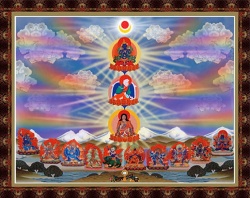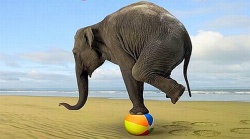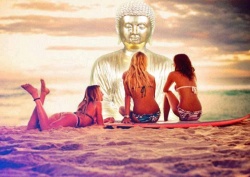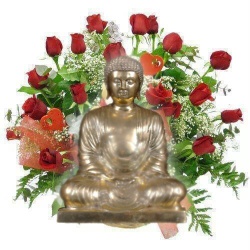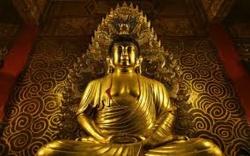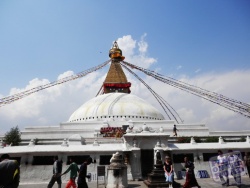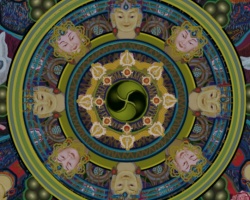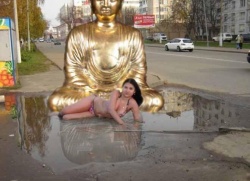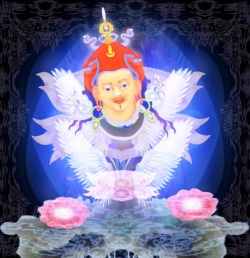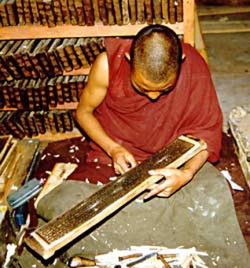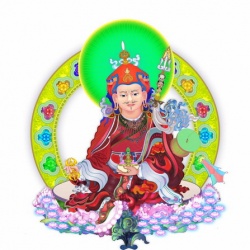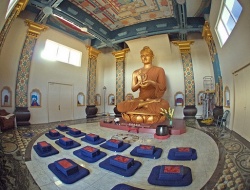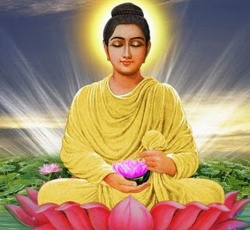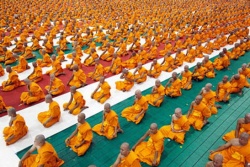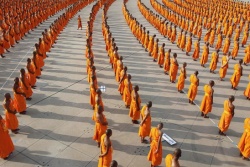Dharmakaya
The first of the three kayas, which is devoid of constructs, like space. The 'body' of enlightened qualities. Should be understood individually according to ground, path and fruition.'
Sanskrit term for the Truth Body of a Buddha. dharmakaya (Fa-shen, cho ku):
This aspect of a buddha represents the mind of a buddha or the truth of the universe and is experienced by those who obtain the direct realization of emptiness. It has no form, does not come or go, is boundless.
It is sometimes also called the Truth Body. Synonymous with “enlightenment” or “original nature” or “sambodhi.”
- The first of the Three Kayas, which is devoid of constructs, and space-like as this nature of all things. The basic and all-pervasive nature of all phenomena.
Dharmakaya also is designated as the 'body' of enlightened qualities. Dharmakaya should be understood individually according to ground, path and fruition. [RY]
The kayas: Various aspects or states of buddhahood. One recognizes two, three, four, or five kayas.
dharmakaya, the absolute body, and
the dharmakaya, or absolute body;
the sambhogakaya, or body of divine enjoyment; and
the nirmanakaya, or manifested body.
These correspond to the mind, speech, and body of an enlightened buddha and are expressed as the five wisdoms.
- Four Kayas: the svabhavikakaya, or essential body, is to be added to the three kayas and represents their inseparability (dbyer med).
- Five kayas: to the three kayas one adds the avikaravajrakaya, the "unchanging vajra body," and the abhisambodhikaya, "body of total enlightenment." Dilgo Khyentse Rinpoche
The Dharmakāya (Sanskrit: धर्म काय; Pali: धम्म कय, lit. "Truth Body" or "reality Body") is one of the three bodies (Trikaya) of The Buddha in Mahayana Buddhism.
Dharmakaya constitutes the unmanifested, "inconceivable" (Sanskrit: acintya) aspect of a Buddha, out of which Buddhas arise and to which they return after their dissolution.
Buddhas are manifestations of the dharmakaya called nirmanakaya (Skt: Transformation body).
One Buddhist scholar writes of it as: 'the Body of reality itself, without specific, delimited Form, wherein The Buddha is identified with the spiritually charged nature of everything that is.
Dharmakaya (chos sku). The first of the three kayas, which is devoid of constructs, like space.
The 'body' of enlightened qualities. Should be understood individually according to ground, path and fruition.
The Dhammakaya Movement of Thailand, and the Tathagatagarbha Sutras of ancient Indian tradition, view the Dharmakaya as the true Self of The Buddha, present within all beings.
Etymology
Tibetan: chos sku "Chos" (Tibetan) can be glossed as "Dharma" (Sanskrit). "Sku" has the meanings: "Body, Form, image, bodily Form, figure". Thondup & Talbott (1996, 2002: p. 48) render it as the "ultimate Body".
In a key scholarly collaborative Nyingmapa translation work published in 2005, furthermore notable as the first complete rendering of the Bardo Thodol into the English Language from the Tibetan, this technical term was configured into English as "Buddha-Body of Reality".
Origins and development
Pali Canon
In the Pali Canon The Buddha tells Vasettha that the Tathagata (The Buddha) is Dhamma-kaya, the "Truth-Body" or the "Embodiment of Truth", as well as Dharmabhuta, "Truth-become", that is, "One who has become Truth" (Digha Nikaya).
During The Buddha's Life great veneration was shown to him. A mythology developed concerning the physical characteristics of Universal Buddhas.
After The Buddha's Parinirvana a distinction was made between the Buddhas physical Body, rupakaya, and his Dharmakaya aspect.
As The Buddha told Vakkali, he was a living example of the 'Truth' of the Dharma. Without that Form to relate to, The Buddha's followers could only relate to the Dharmakaya aspect of him.
Trikaya Doctrine
The Trikaya Doctrine (Sanskrit, literally "three bodies" or "three personalities") is a Buddhist teaching both on the nature of reality, and the Appearances of a Buddha.
The Dharmakaya-Doctrine was possibly first expounded in the Aṣṭasāhasrikā prajñā-pāramitā (Perfection of Wisdom|The Perfection of Insight In Eight Thousand Verses), composed in the 1st century BCE.
Around 300 CE, the Yogacara school systematized the prevalent ideas on the nature of The Buddha in the Trikaya or three-Body Doctrine.
According to this Doctrine, Buddhahood has got three aspects:
- The Nirmana-kaya, or Transformation-Body,
- The Sambhogakaya, or Enjoyment-Body,
- The Dharmakāya, or Dharma-Body.
Qualities
Tulku Thondup in "Masters of Meditation and Miracles: Lives of the Great Buddhist Masters of India and Tibet" states that Dharmakaya must possess three great qualities:
- Great purity (Wylie: sPang Pa Chen Po),
- Great realization (Wylie: rTogs Pa Chen Po),
- Great Mind (Wylie: Sems Pa Chen Po).
Immortality
Unlike ordinary unenlightened persons, Buddhas (and Arhats) do not die (though their physical bodies undergo the cessation of biological functions and subsequent disintegration).
Interpretation in Buddhist traditions
Theravada
Predominantly, Theravada Buddhism views the Dhammakaya (Dharmakaya) as a figurative term relating to the manner in which The Buddha exemplifies or embodies the Dharma. Theravada Buddhism does not usually invest the term Dhammakaya with a metaphysical connotation.
Dhammakaya Movement of Thailand
The Dhammakaya Movement of [[Thai Theravada] Buddhism]] supposedly has doctrinal elements which distinguish it from conventional Theravāda Buddhism.
The Dhammakāya school of Meditation is marked by its literal interpretation of Buddhist technical terms, including the term dhammakāya, in their physical meaning, as described by Phramongkolthepmuni.
In some respects its teachings resemble the Tathagatagarbha (Buddha nature) doctrines of Mahāyāna Buddhism.
Basing itself on the Pali suttas and Meditative experience, it teaches that the Dhammakaya is the Eternal Buddha within all beings.
The dhammakaya (dharmakaya) is Nirvana, and Nirvana is equated with the true Self (as opposed to the non-Self):
Paul Williams has commented that this view of Buddhism is similar to ideas found in the Shentong teachings of the Jonang school of Tibet, made famous by Dolpopa.
The Thai Meditation masters, pre-eminently of the Dhammakaya Movement, who teach of a true Self of which they claim to have gained Meditative experience, are not rejected by Thai Buddhists in general, but tend, on the contrary, to be particularly reverered and worshipped in Thailand as Arhats or even Bodhisattvas, far more so than more 'orthodox' Theravada Monks and scholars.
Mahayana
Tathagatagarbha-tradition
In the Tathagatagarbha sutric tradition, the Dharmakaya is taught by The Buddha to constitute the transcendental, blissful, eternal, and pure Self of The Buddha.
"These terms are found in sutras such as the Lankavatara, Gandavyuha, Angulimaliya, Srimala, and the Mahaparinirvana, where they are used to describe The Buddha, the Truth Body (dharmakaya) and the Buddha-nature."
They are the "transcendent results [of spiritual attainment)".
Lotus Sutra
In the Lotus Sutra (sixth fascicle) The Buddha explains that he has always and will always exist to lead beings to their salvation.
Tibetan Buddhism
Padmasambhava, Karma Lingpa, Gyurme Dorje, Graham Coleman and Thupten Jinpa define "Buddha-Body of Reality", which is a rendering of the Tibetan chos-sku and the Sanskrit Dharmakāya, as:
- The ultimate nature or essence of the Enlightened Mind (byang-chub sems), which is uncreated (skye-med), free from the limits of conceptual elaboration (spros-pa'i mtha'-bral),
empty of inherent existence (rang-bzhin-gyis stong-pa), naturally radiant, beyond duality and spacious like the sky.
The intermediate state of the time of Death ('chi-kha'i bar-do) is considered to be an optimum time for the realisation of The Buddha-Body of Reality.
Reginald Ray, Writing of The Vajrayana view of the Dharmakaya, defines it as:
- The Body of reality itself, without specific, delimited Form, wherein The Buddha is identified with the spiritually charged nature of everything that is.
Rime movement
According to Jamgon Kongtrul, the founder of the Rime movement, in his 19th century commentary to the Lojong slogan, "To see confusion as the four kayas, the Sunyata protection is unsurpassable" (as translated by Ken McLeod) when one meditates on ultimate Bodhicitta and rests in a state where Appearances simply appear but there is no clinging to them, the dharmakaya aspect is that all Appearances are empty in nature, the Sambhogakaya is that they appear with clarity, the nirmanakaya is that this Emptiness and clarity occur together, and the svabhavikakaya aspect is that these are inseparable.
Gyaltrul Rinpoche's Dharmakaya Organization
Recently, Dharmakaya has also become the name for an organization founded by H. E. the 4th Trungram Gyaltrul Rinpoche, and is affiliated with his global organization the United Trungram Buddhist Fellowship (UTBF).
Gyaltrul Rinpoche's Dharmakaya organization was founded for the specific purpose of bringing the teachings and Meditation practices from the Trungram Tradition of the Karma Kagyu lineage to North America.
Iconography
Emptiness
In the early traditions of Buddhism, depictions of the Shakyamuni Buddha were neither iconic nor aniconic but depictions of empty space and absence: petrosomatoglyphs and footprints, for example.
This is a worthy visual device to draw attention to the 'absence' and 'Emptiness' of "thus gone" (Sanskrit: Tathāgata) and the Doctrine of Śūnyatā and represent whilst not representing. Later representations of The Buddha were introduced as "skillful means" (Sanskrit: upāya).
Sky-blue
Thondup & Talbott identify Dharmakaya with the "naked" ("sky-clad"; Sanskrit: Digāmbara), unornamented, sky-blue Samantabhadra:
- In Nyingma icons, Dharmakāya is symbolized by a naked, sky-coloured (light blue) male and female Buddha in union Kāmamudrā, called Samantabhadra [and Samantabhadri).
Fremantle states:
- Space is simultaneously the first and the last of the great elements. It is the origin and precondition of the other four, and it is also their culmination...
The Sanskrit word for space is the same as for the sky: akasha, which means "shining and clear." What is it that we call the sky?
It marks the boundary of our vision, the limit our sight can reach. If we could see more clearly, the sky would extend infinitely into outer space.
The sky is an imaginary boundary set by the limitations of our senses, and also by the limitations of our mind, since we find it almost impossible to imagine a totally limitless Universe.
Space is the dimension in which everything exists. It is all-encompassing, all-pervading, and boundless. It is synonymous with emptiness: that emptiness which is simultaneously fullness.
The colour blue is an iconographic polysemic rendering of the Mahābhūta (Sanskrit element), the "pure light of space' (Sanskrit: Ākāśa).
The conceptually bridging and building poetic device of analogy, as an exemplar where Dharmakaya is evocatively likened to 'sky' and 'space', is a persistent and pervasive visual metaphor throughout the early Dzogchen and Nyingma literature and functions as a linkage and conduit between the 'conceptual' and 'conceivable' and the 'ineffable' and 'inconceivable' (Sanskrit: acintya).
It is particularly referred to by the Gongpa Zangtal, a terma cycle revealed by Rigdzin Gödem (1337–1408) and part of the 'Northern Treasures' or 'Jangter' (chang ter; Wylie: byang gter).
Mirror
Sawyer conveys the importance of mirror iconography to Dharmakaya:
- The looking glass/mirror (T. me-long, Skt. adarsa), which represents the dharmakaya or Truth Body, having the aspects of purity (a mirror is clear of pollution) and wisdom (a mirror reflects all phenomena without distinction)
